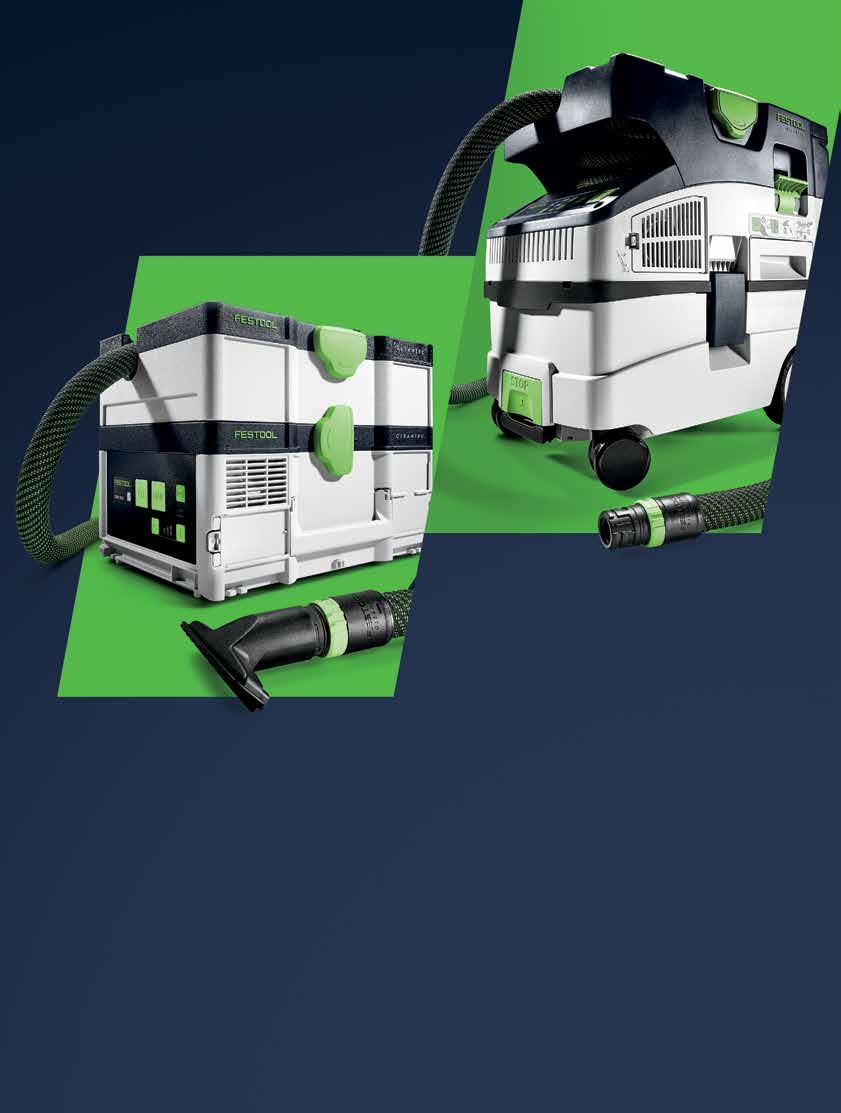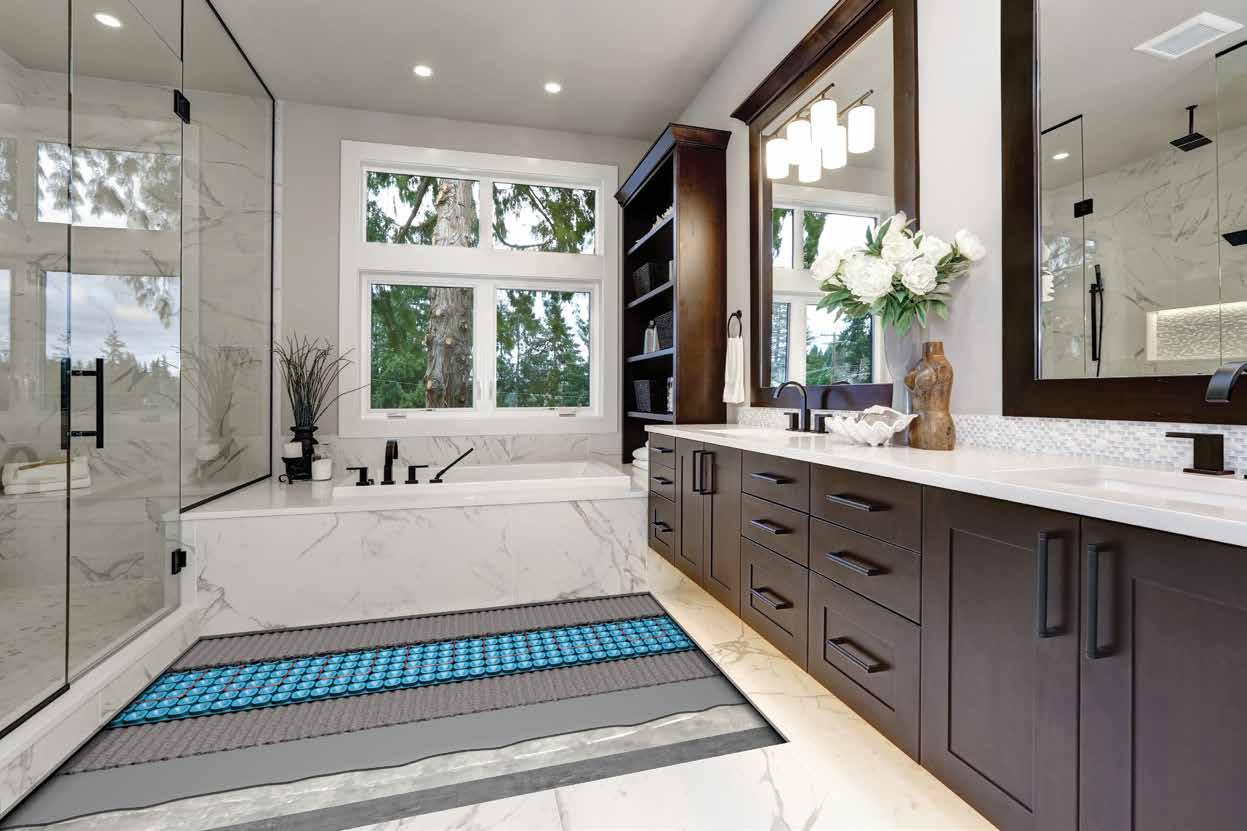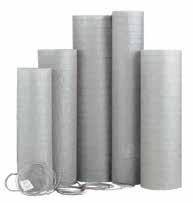
















LIVING IN TORONTO, one of the closest destinations for a day trip is Niagara Falls. My family’s last voyage included Journey Behind the Falls and Dinosaur Adventure Golf — hands down the best place to enjoy an 18-hole round of mini putt. And, of course, the journey would not have been complete without a leisurely walk along Niagara Parkway to where the Niagara River cascades over Horseshoe Falls. Every visit to the city of the natural world wonder involves trying something new and our next one will undoubtedly include dining at Table Rock House Restaurant. Perched on the brink of the falls, with views as close as it gets, the renovated restaurant is part of the revamped Table Rock Welcome Centre, designed by Johnson Chou Inc. in conjunction with Ventin Group Architects. Completed in 2021, the project is the focus of our Then & Now column. You can read all about the new flooring that’s making a splash in A Welcome Change.
But to begin, Steve Vasconcelos of The Floor Studio Inc. returns as our Installation Matters guest columnist. This time around, the certified National Wood Flooring Association inspector tackles the best flooring materials for condominiums, common installation problems and mistakes to avoid.
We then turn to the main focus of the fall edition: training and education. National Floor Covering Association CEO Chris Maskell addresses the need for a ‘wholistic’ approach to learning and what that entails in 360-degree Education. Then, International Standards and Training Alliance director John T. McGrath Jr. delves into how flooring installers can ‘cut through’ the plethora of certification options to select the program that’s right for them in The Value of Training. Rounding out this all-too important section, Dan Marvin of Schluter Systems discusses five new designations in the Areas of Use table of ANSI 326.3, American National Standard Test Method for Measuring Dynamic Coefficient of Friction of Hard Surface Flooring Materials; and Lamar Starks of Shaw Industries speaks to how retail associate product training can help improve customer interactions and close more sales.
Next is our flooring focus: carpet. Leslie Thompson of Tarkett North America breaks down the benefits of bringing this soft surface flooring material into the office. We then virtually ‘sat down’ with Interface’s Kari Pei. The vice-president of global product design walks us through the textile production process, from initial inspiration to actual carpet on the floor, in a Q&A.
Last but certainly not least is our product showcase, which features some of the newest flooring materials, accessories, tools and equipment, followed by industry stats and facts. If you’d like to share a product launch, company or flooring-related news with our readers, contact me at claret@mediaedge.ca.
Clare TattersallPUBLISHER Jason Krulicki jasonk@mediaedge.ca
EDITOR Clare Tattersall

PRESIDENT Kevin Brown kevinb@mediaedge.ca
CIRCULATION circulation@mediaedge.ca
CO-PUBLISHER Dan Gnocato dang@mediaedge.ca
ART DIRECTOR Annette Carlucci
GRAPHIC DESIGNER
Huynh
PRODUCTION MANAGER
Louis
Coverings
Copyright
2001 Sheppard Avenue East, Suite 500, Toronto, Ontario M2J 4Z8
2022 by MediaEdge Communications. All rights reserved.
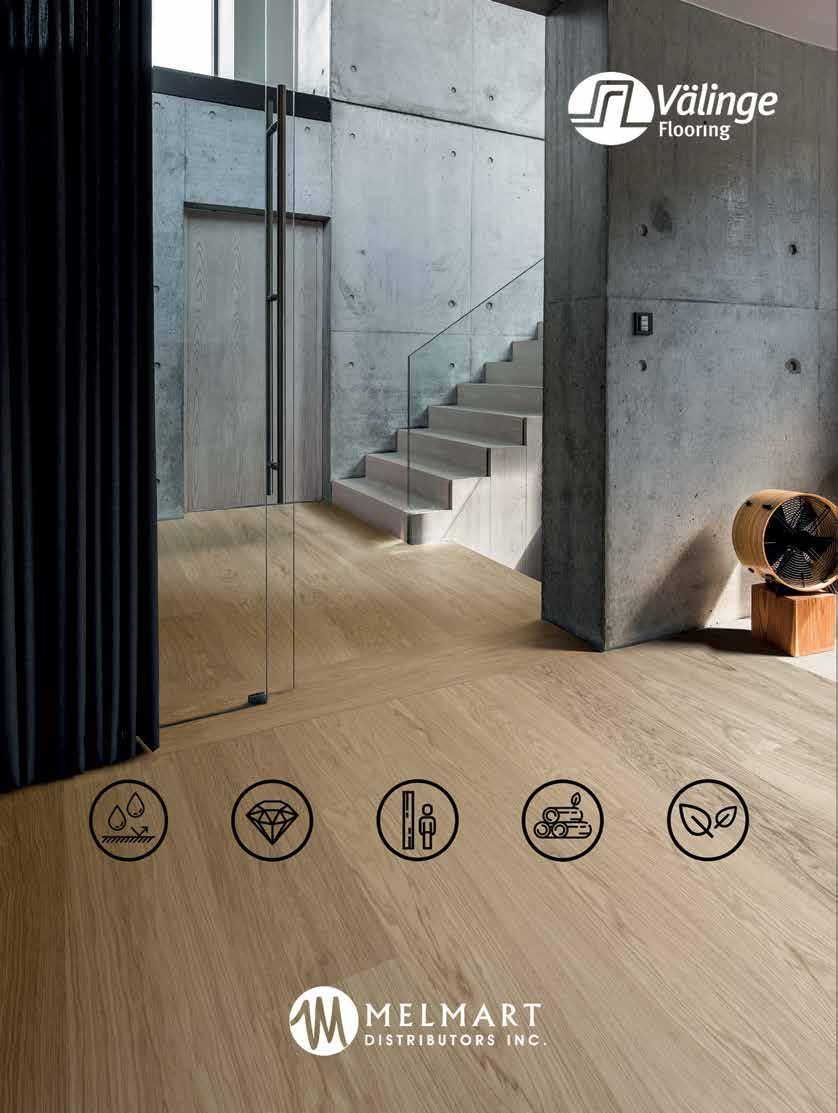


Flooring is one of the most important design elements in a condo minium. The first thing people generally notice when they enter a unit, the choice of flooring impacts the ambiance and mood, as well as sets the tone for the rest of the space. Plus, it can affect resale value.
Selecting the right flooring material is not always a simple task, though. Unlike the 70’s and 80’s, when the main options were wall-towall broadloom or parquet, there are an endless number of products available in the market today, from laminate to luxury vinyl plank (LVP) to herringbone and chevron wood flooring.
Laminate flooring has always been an affordable option that’s easy to install, durable and comes in a wide range of styles and co lours. LVP has seen a huge spike in popularity in recent years because it’s sturdy, easy to maintain and worry-free for investor homeown ers who rent their units. Making its way into the mainstream is her ringbone and chevron wood flooring, which offer a unique look with its diagonal patterns. What’s more, it can be installed on any type of surface, including concrete substrates found in condos.
Regardless of which material is being installed, the flooring proj ect begins long before the first box is cut open and ready to rack out. Be sure to follow the manufacturer’s pre-installation instructions and ensure job site conditions are met. As obvious as this may seem, this step is often overlooked.
To begin, confirm the subfloor is flat and within the manufactur er’s recommended tolerance. This will restrict vertical movement of a floating floor. In extreme cases, the floor’s locking mechanism can break or separate, which is not a quick fix and may affect the original manufacturer’s warranty should the flooring mechanism need to be altered in order to correct the issue.
When installing a double glue-down product, uneven subfloors of fer a unique set of challenges. The popular hollow sound complaint during final walk-through is never comfortable. Although hollow sounds are not necessarily considered a deficiency unless there is vertical movement present, they cause problems when trying to col lect final payment.
In today’s highly competitive market, it’s surprising that with all the information and technology at the industry’s fingertips, many floor ing contractors have still not invested in a wood moisture or relative humidity (RH) meter. In Canada, it’s imperative to measure RH in a highrise condo between January and March. It’s not uncommon for the meter to read between nine and 25 per cent RH. (Industry stan dards and guidelines typically recommend 35 to 50 per cent RH.) If this occurs, a waiver should be signed by the customer acknowledg ing they understand their condo conditions do not meet the flooring manufacturer’s guidelines. This will protect the installer’s reputation and bank account. Proceeding to install the floor under these condi tions without a waiver could end very badly down the road.
One of the most common errors made by installers relates to acoustical sound control underlayments. Underfloor treatments are
normally recommended or required by code in new condo projects. Many condo corporations also require them in existing buildings to help reduce impact sound transmission between units.
A lack of quality sound control underlay has caused frustration and anger among residents and management of condominium com munities across Canada. The issue became even more pronounced during the Covid-19 pandemic with the move to remote work to lim it the spread of the virus, and has remained at the forefront as many people continue to work from home.
Flooring contractors would be well-served to put some thought into selecting an appropriate acoustic membrane for installation un der the floor. Never take claims printed on packaging at face value. Alone, they are not enough to confirm a product meets a project’s cri teria. A common error is installation of an acoustic membrane that was tested with a suspended ceiling assembly in a unit that does not have this type of ceiling system. Although not a flooring deficiency, shared accountability may fall in the flooring contractor’s lap should noise complaints arise and a simple inspection determines the wrong acoustic sound control underlayment was installed.
It’s also important to consider the performance of the material used to achieve acoustic sound control. Rubber is a high-perfor mance material that’s ideal for reducing impact and vibration noise. It can have a field impact insulation class (FIIC) rating as high as 70. One of the main factors that sets rubber apart from other materials is its high shear modulus. Products with a high shear modulus value are very rigid. In other words, a large force is required to deform the rub ber underlayment. (A low shear modulus value indicates the underlay ment is soft or flexible and little force is needed to deform it.) This means rubber can endure the constant loads that come with install ing laminate, LVP and hardwood floors.
Steve Vasconcelos is owner of The Floor Studio Inc., a supplier of spe cialty hardwood, engineered flooring, luxury vinyl tile and sound attenuation products. Steve is also an accredited National Wood Flooring Association inspector with more than 25 years of experi ence in the flooring industry that includes analyzing acoustic test reports and membranes. He can be reached at 416-533-2855 or steve@thefloorstudio.ca
A common error is installation of an acoustic membrane that was tested with a suspended ceiling assembly in a unit that does not have this type of ceiling system.
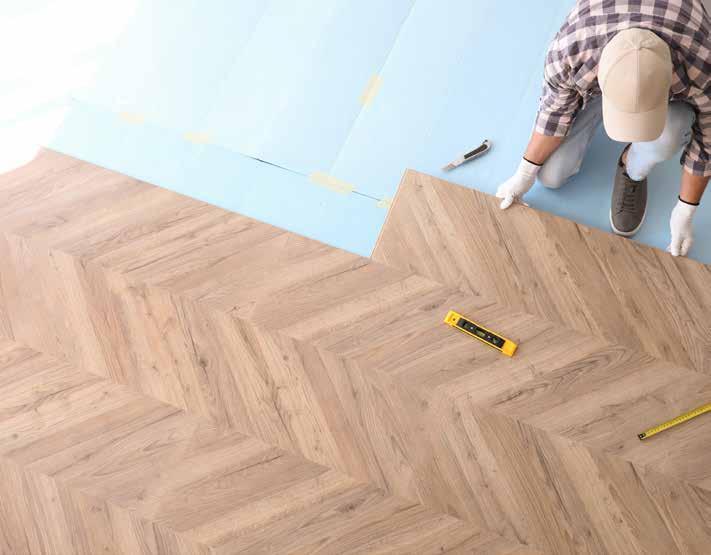 By Chris Maskell
By Chris Maskell
We’ve got a problem. There’s a shortage of floor covering install ers in this country due to retire ment, a lack of new blood and existing install ers, switching trades early or mid-career. Because of this, it’s vital we retain existing installers while at the same time we attract and educate a new generation.
But education doesn’t start and stop with the installer. Far from it. All stakeholders on a project should have at least a rudimentary
understanding of how a floor installation fits successfully into a fast-paced construction environment. All too often, installers end up on-site way too early, where they’re told to get the job done even though they know conditions will lead to failure.
Why would they want to face that scenario every week?
Installers shouldn’t have to fight about preparation responsibilities, concrete moisture testing, turning the heat on and
more. While some push and shove on-site is always expected, a demand that could lead to floor failure is not acceptable. It’s no wonder existing installers consider switch ing trades (and actually do).
How can we remedy this?
One way is 360-degree education for all parties involved. This includes address ing correct processes and budgeting, and scheduling time to prepare a site before the installer is dispatched to start work. A group-
wide understanding of this will increase the likelihood these issues will be discussed early on and give everyone the information they need to prepare a site properly. In turn, it will create a better work environment for installers who might otherwise take a sec ond look at the trade and decide it’s not for them.
So, what training is available for the vari ous parties?

Training is not easy to come by. There are lim ited options. It is offered directly to flooring shops through manufacturers who provide product-specific training. This often comes with a certificate of completion. Industry re
fers to this as being Product Qualified (PQ). There are also apprenticeships that service both union (through the International Stan dards and Training Alliance) and non-union installers, requiring 6,000-plus hours of floor installation experience, classroom time and the passing of a written exam. A journeyman installer is referred to as Trade Qualified (TQ). Both PQ and TQ installers are recognized by the National Floor Covering Association (NFCA). These qualifications are required to meet NFCA installation standards — a speci fication that is now being used by architects across the country.
Floor coverings is a ticketed Red Seal trade. Unfortunately, the Red Seal program for flooring has been poorly attended for
years to the point where in some provinces, it has completely fallen off the radar. Each province deals with trades training differ ently. It would also help if training authorities across the country talked to each other and aligned their efforts to attract more interest in the trade.
The salesperson/estimator negotiates tim ing, sets expectations and is the primary point of contact for the constructor. So, it’s important that they can confidently spell out site requirements that can affect conditions and productivity right from the get-go. This training is more random and doesn’t follow a curriculum. You just learn along the way
All too often, we see missed details in the specs resulting in ambiguity on-site and another installer being told to take shortcuts because deadlines trump quality — something other tradespeople like electricians would never entertain.

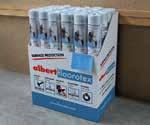


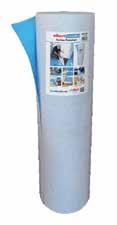
— ‘baptism by fire’ is the norm. As there is no formal qualification or certificate program where you can earn a designation, flooring dealers are left to organize training themselves. Product manu facturers are the typical go-to resource delivering product knowl edge. This is good but rarely is there a session with the manufac turer that discusses the necessity of having a flat substrate, heat on, relative humidity under control, dew point managed and so on. Sales doesn’t focus on this but it should.
The same information about process is very useful for architects, too. Architects must understand how to represent best practices in their written specifications and through use of the various archi tectural divisions, as well as allocate work responsibilities to the right parties. All too often, we see missed details in the specs resulting in ambiguity on-site and another installer being told to take shortcuts because deadlines trump quality — something other tradespeople like electricians would never entertain. Yet, flooring installers are pushed to break the rules because too many people don’t know any better and specifications fail to align with the trade scope of work for a floor covering installer. Imagine the stress for the specification writer who is having to guide construction by writing about processes they may only have a limited understanding about.
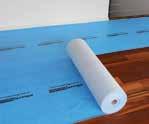

The general contractor has to understand the same information. They need to anticipate challenges, so that they can navigate the flooring minefield. They also have to budget correctly at time of bidding because they are responsible for paying the skilled trades for the required work.
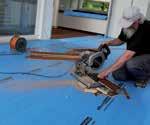
Trade associations also have a role. They hold training of this type (process and procedure) from an unbiased standpoint, sharing gen eral industry information and standards as opposed to training on specific products. This type of classroom or virtual education is ef fective for reaching all parties and putting them on the same page.
There is an incredible wealth of knowledge and understanding within the skilled trades but sharing and disseminating it is an ongoing challenge. The industry is so busy it tends not to look up unless there’s a problem. We pay attention to the wheels that have come off rather than oil the squeak and plan ahead to avoid a big problem.
With a 360-degree approach to education and the ability to share knowledge with a wider audience, there is blue sky ahead. But, as always, there is still more work to be done.
Chris Maskell is CEO of the National Floor Covering Association (NFCA). Chris has worked in the floor covering industry for more than 29 years. During this time, he has been a flooring contractor, manufacturer’s rep resentative and business owner. As CEO of NFCA, he works with the board of directors to promote NFCA standards and updated specifica tions for commercial floor covering installations. He also operates the NFCA’s quality assurance program, a specifiable third-party inspection review service for commercial projects, and is a certified floor covering inspector.
„The best choice for protecting your floor.“
SmartStrand features Mohawk’s exclusive All Pet Protection & Warranty, one of the most comprehensive pet warranties in the industry.
All Accidents. All Pets. All the Time.
No wonder SmartStrand has been installed in more than 11 million homes – and counting!
Learn more by contacting your sales representative or visiting MohawkToday.com.
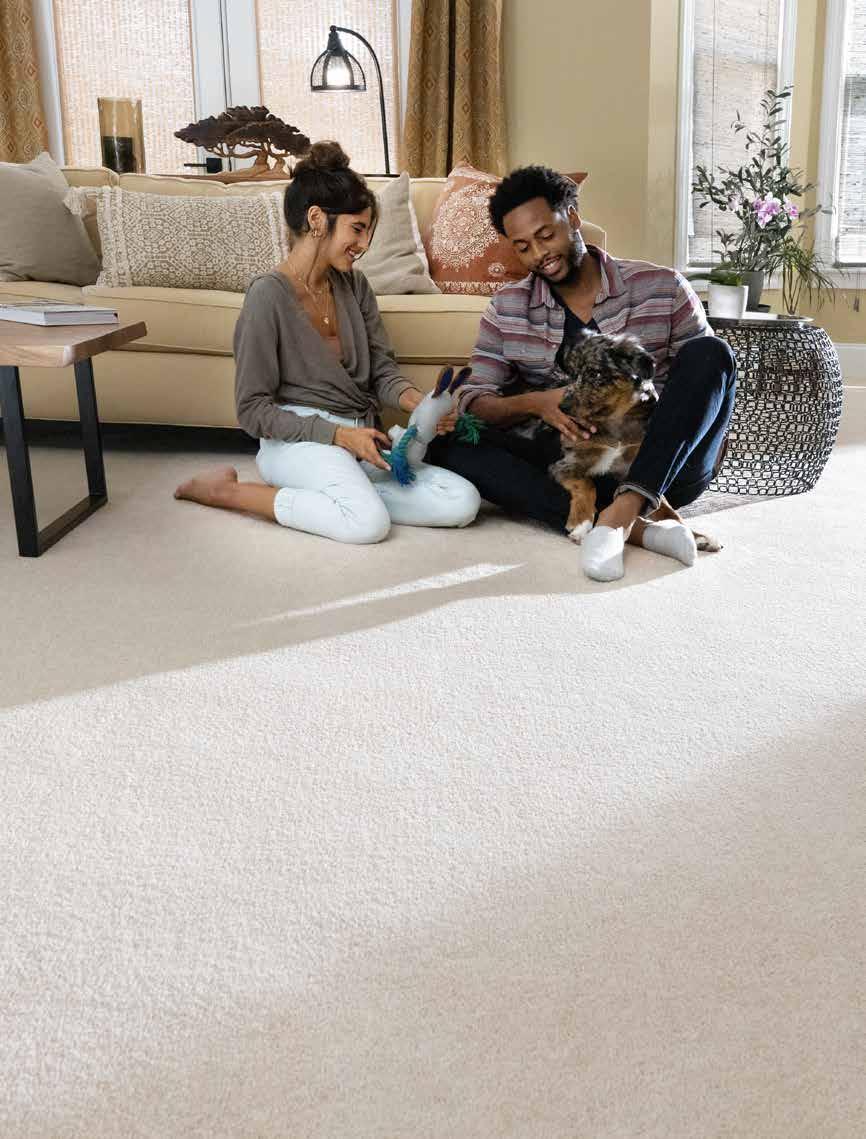
your customers can keep the “aw” in paw.
 By John T. McGrath Jr.
By John T. McGrath Jr.
How to narrow down program selections to reap optimal benefits
Simply put, certified floor covering in stallers are the best installers for the job. However, a certification program without a bona fide training component is an empty vessel. Given there are so many cer tification options to choose from, it may be difficult to determine the ‘right’ training and program, led by the most knowledgeable in structors.
It’s vital to start with a program coordinat ed by a leading training organization that is guided by industry leaders, manufacturers and technical experts. With the ability to draw subject matter experts from various corners of the industry who have their fin ger on the pulse of potential challenges in stallers may face, these organizations can quickly formulate solutions and review and implement new certification standards. This ensures installers are consistently learning the latest skills, gaining the most relevant product knowledge and becoming more ef ficient, bringing peace of mind to their cus tomers that each flooring project is installed correctly the first time.
The most comprehensive training programs address real-world applications for apprentic es to experienced installers who may need to hone their skills. It is ideal to look for floor cov ering programs that re-examine best practic es and offer career-long skill building and pro fessional development, no matter where the installer is on their career path.
For instance, there are many new tech nological improvements in eco-friendly ma terials and the aesthetics of glue-down in stallations. To address this, the International Standards and Training Alliance (INSTALL) updated its training and certification stan dards. Both look closely at specific details, including how to properly prepare the sub strate, select the applicable adhesive for the material and apply the adhesive with the prop er trowel notch, as well as address the appro priate open time for the adhesive. In addition to being attuned to industry trends, more ad vanced carpet training and certification stan dards will push installers to master higher lev el skills in seaming and pattern-matching.
Manufacturers are continuously making strides in product advancement. To keep pace with these progressions, efficiencies are always being made within the floor cov ering industry. It’s important to look for floor covering installation training programs con ducted by leading organizations that are consistently updating and advancing stan dards and certifications.
For instance, as more commercial proj ects incorporate luxury vinyl tile (LVT) and luxury vinyl plank (LVP) installations, IN STALL has made improvements to its resil ient flooring certification. Recent advance ments to the curriculum include instruction on random pattern LVT and LVP installation — an increasingly common design aesthetic in commercial settings.
In order to prevent flooring failures, the substrate must be examined and proper ly prepared before LVT or LVP patterns are laid, as with any flooring material. All sub strate preparation certification courses should address the potential for concrete moisture presence and mitigation since this is an integral concern. Flooring contractors and installers should look for programs that address proper training in recognizing and mitigating sources of moisture. It’s import ant to have the most up-to-date knowledge to protect the flooring installation’s integrity and occupant health.
Reputable organizations will offer com prehensive courses that also include train ing in health and safety. Especially essen tial in healthcare facility renovations, this additional training should include the best methods for protecting installers, patients and staff in order to keep them safe during construction and long after. In the wake of Covid-19, it is particularly critical for a floor covering installation curriculum to include necessary instruction on both personal pro tective equipment and patient protective equipment. The knowledge and compliance of these practices are required to receive certification in many courses.
Keeping skills relevant with training is imper ative and should not be an option. Even sea soned floor covering installers need to enrol in training courses to remain at the top of the industry. Neglecting to stay current on train ing can result in inefficient, unprepared in stallers and lead to flooring failures.
Training organizations that partner with flooring manufacturers can adapt their cur riculum to ensure training covers product evolution, teaching installers about new materials and ideal techniques for install ing them. In addition, training organizations that regularly meet with industry leaders to discuss better installation methods and tools will ensure their training is ahead of the curve.
Because floor covering installation re quires career-long training, experts agree training updates should be taken yearly. Reg ular enrolment in training courses guaran tees installers are retaining certifications and assures customers their floor covering team is a safe bet.
North America offers a vast number of training and certification opportunities. Choosing a program can seem overwhelm ing. Installers should select courses held at state-of-the-art facilities that focus on both the theory and practice of prop er installation, and that also cover a com prehensive selection of flooring materi als. Cutting edge training programs will focus on fundamental and advanced skills, working efficiently and include les sons on safety.
Contractors can help keep their crews and businesses at the forefront of the trade by concentrating on quality floor covering installation training. This reduces the likelihood of costly rework and safety hazards, while increasing their productivi ty and quality of work — ensuring beautiful installations that will perform as intended over the long haul.
John T. McGrath Jr. is a director at the International Standards and Training Alliance (INSTALL), an association of installers, contractors and manufacturers who collaborate to improve industry standards and provide professional, reliable flooring installation teams.
In 2022, the North American tile industry introduced a new table in the tile stan dards that requires manufacturers to declare where their products can be used based on slip resistance characteristics. Soon, products will be labelled interior, dry (ED), interior, wet (EW), interior, wet plus (EW+), exterior, wet (EW) and oils/greases (O/G). These product use classifications will also show up in specifications and construc tion documents, so it is worth understand

ing why they were introduced and how they should be interpreted.
Unlike other flooring products, the tile in dustry has worked extensively to define how resistant theirs are to slipping. The first iter ation of this effort was a definition of static coefficient of friction (SCOF) in the ‘80s and ‘90s, which was formalized as ASTM C1028. This test was conducted by placing a weight ed piece of rubber on the tile, pulling on it and then recording the amount of force required
to start the weight moving. A wet SCOF of 0.6 emerged as an early indicator of tiles that had sufficient slip resistance for floors in moderately wet areas.
By the early 2000s, the limitations of this test method were becoming obvious. The re sults were dependent on who was conduct ing the test and how the rubber pad was pre pared. Tiles that should not have been used in wet areas were causing slipping hazards despite specifiers’ attempts to use the ‘right’
tiles. A new test was required; it was pub lished in 2012, as a dynamic coefficient of friction (DCOF).
DCOF uses a robotic device called a tri bometer that pushes a rubber square across a wet tile and records the resistance to movement. The old SCOF of 0.6 was replaced with a DCOF of 0.42 for horizontal surfaces that could be expected to be wet. The test method is detailed in ANSI A326.3.
A reproducible test method was a great first step but the categories of ‘dry appli cations only’ and ‘some wet applications’ weren’t explicit enough to make sure the correct tiles were being specified for the right areas. The tile industry went back to work to develop a table that provided great er guidance on which tiles should go in which environments. This table was added to ANSI A326.3, published in 2022, and is now part of the standards for all ceramic and glass tile types covered by the international standards organization. The following five categories are included.
Products labelled interior, dry have a dry DCOF of at least 0.42, but will typically not list a wet DCOF. At a minimum, most ceramic and glass floor tiles currently on the market meet this criterion. The stan dard gives some examples, such as in door malls (excluding food courts), hotel lobbies, office buildings, showrooms and rooms in houses other than bathrooms and kitchens.
Interior, wet products have a wet DCOF of 0.42. The manufacturer may also know through experience that these products can be used in wet areas. Examples listed in the standard are entry foyers, public restrooms without showers, grocery stores, front of house areas in restaurants with separate kitchens and home interiors, including bath rooms and kitchens.
\\ Unlike other flooring products, the tile industry has worked extensively to define how resistant theirs are to slipping.
These products are manufacturer-declared and may or may not have a wet DCOF of 0.5 or greater. Examples listed in the standard are the front of house in fast casual and quick service restaurants, food areas in gas sta tions and similar spaces where floors may be walked on while wet but are free of standing water and other contaminants.
Another manufacturer-declared category, exterior, wet products may or may not have a wet DCOF greater than 0.55. Examples in clude pool decks, walkways, patios and side walks. Typically, these tiles have a heavily textured surface or other traction-enhanc ing features.
Products labelled oils/greases are also man ufacturer-declared as suitable for this appli
cation. They may or may not have a wet DCOF above 0.55, and will frequently include abra sive grains, heavy structure or other trac tion-enhancing features like a raised tread pattern. Application examples include back of house restaurant use, food preparation areas where fats and greases are present and areas exposed to automotive fluids.
Manufacturers have started adding one or more of the new categories of IW+, EW and O/G to the literature for their products. This will allow specifiers, architects and even homeowners to determine the best-suited tile for their specific environment.
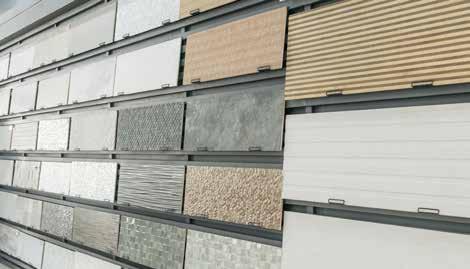
For a full explanation of each classifica tion, including specific exclusions, a free copy of the ANSI A326.3 standard is available for download from the Tile Council of North America and Terrazzo, Tile and Marble Asso ciation of Canada’s websites.
Dan Marvin is director of product standards and sustainability for Schluter Systems, a man ufacturer of innovative tile installation products for dry and wet areas. Dan has worked for tile and installation products manufacturers for more than 30 years in technical roles.
Interior, dry and interior, wet were essentially the pass/fail categories used since 2012. With the revised standard, the concept of additional manufacturer-declared classifications emerged. Manufacturers can allow their products to be listed in these classifications based on DCOF testing, other testing like the German ramp R values (referenced in many Canadian specifications) and British pendulum, and their experience regarding where tiles are typically used without problem.
 By Lamar Starks
By Lamar Starks
In the flooring marketplace, retail spac es can sometimes feel foreign and over whelming to consumers: What am I look ing for? Where should I go? What do I need? Who can I talk to?
With so many questions surrounding con sumers and their flooring journey, the help of an informed and well-trained retail sales as sociate (RSA) can make all the difference in their conversion, from searching to purchas ing. By providing both live and virtual train ing sessions, as well as knowledgeable and available territory managers (TMs), manu facturers can empower their RSAs to elevate the sales floor for improved customer inter actions that help to close more sales.
In today’s hybrid environment of virtual re sources, online shopping and in-person in teractions, human connections can fall by the wayside. When the focus is on the bot tom line and quick turnover, it can be easy to lose sight of just how valuable these connec tions can be within the marketplace. The re lationship between a TM and their RSAs plays a significant role in the training of an effec tive RSA.
Knowledgeable, reliable and trusted TMs are an invaluable resource to RSAs. TMs tend to be more localized than the manufacturer, providing the RSA with a product expert on their own turf. Wheth
er they need to call with a specific ques tion or just have someone drop by every so often to see how they’re doing, having a manufacturer representative nearby helps to build customer loyalty with and confidence in the people, products and brand as a whole. By thoroughly training TMs, brand subject matter experts are created that RSAs can rely on to improve their own knowledge. Feeling heard and cared for by their TMs and by the brand as a whole can trickle down to consum ers and help to close more sales through improved human connection. To put it simply, happy associates make happy cus tomers.
The global pandemic that shut down the world in 2020 shifted consumer priorities, focusing more on personalization and com fort of the home. Eyes turned to the global supply chain as boats got stuck and prod uct arrivals were delayed. With this shift also came the propensity toward e-commerce over in-store purchases, causing industries to change their tactics in order to reach con sumers where they were shopping.
This online shift affected the relationship between manufacturers and their retail cus tomers, as well. In-person conferences, ed ucation sessions and meetings had to be replaced with virtual webinars or video re cordings in order to maintain the stream of information from manufacturers, through retailers and on to the consumer.
A key aspect of the consumer-retailer re lationship is the trust built by adequate in dustry knowledge. Consumers rely on RSAs to provide them with product information, installation methods, trim and accessory pairings, and so much more. In a recent sur vey, 73 per cent of consumers agreed cus tomer experience helps to drive their buy ing decision. Webinars, instructional videos and in-person training events are all ways in which manufacturers can inform RSAs about products. These training tools can be customized to address the specific needs of RSAs, consumer pain points or highlight marketing initiatives.
Knowledge creates trust, which in turn creates loyalty. Increasing RSA product knowledge through these trainings can im prove their selling stories to effectively and purposefully share this information with consumers, further encouraging the con version to purchase.
Leave behinds like samples and brochures, and additional informative tools, such as webpages and QR codes, are also useful in conveying and sharing product knowledge. Printed brochures can give a positive brand impression while webpages can communi cate more specific details, such as financ ing information or product warranties. QR codes ensure manufacturers can pro vide RSAs and homeowners with the most up-to-date information. Including these additional tools in RSA training or basic RSA interactions can help to boost over
\\ By providing training sessions, as well as knowledgeable and available territory managers, manufacturers can empower their retail associates to elevate the sales floor for improved customer interactions that help to close more sales.

all knowledge and give retailers a resource to refer back to, increasing confidence for both the RSA and consumer.
Leading manufacturers leverage such tools to create resources that meet RSA needs, address consumer frustrations and highlight brand initiatives. For example, a fi nancing brochure addresses a consumer pain point regarding pricing, meets the RSA need for financing information and high lights the brand’s financing options. Right from the start, the RSA feels more knowl edgeable having this information on hand,
the consumer leaves with something they can take home that will keep the retailer and brand on their mind throughout their flooring journey and the brand communicates mean ingful information about their financing op tions.

Resources and tools like these are a win for everyone, though it’s especially import ant for retailers to leverage them. Communi cation with manufacturing partners about what RSAs need is also crucial in order to close more sales and continue with business growth.
Lamar Starks is senior sales training manager at Shaw Industries, which supplies carpet, resilient, hardwood, laminate, tile and stone flooring products and synthetic turf to residen tial and commercial markets worldwide. Lamar leads Shaw’s residential sales training ef forts with a customer-centric philosophy focused on the sales process, products, technolo gy and how to effectively be a live resource for retail sales associates.
Grout provides the accent to every tile installation; ‘a touch of color’ that can create subtle or dramatic contrasts that help shape the mood of a room. When trying to achieve a desired look, choosing the right grout color to accompany a tile can be just as important as the tile itself. This is why PROMA has formulated a wide selection of the most fashionable grout colors available to help make your choice an easy one. Contact PROMA toll-free at 1-866-51-PROMA (77662) or visit www.proma.ca to order a Grout Color Card or Kit.
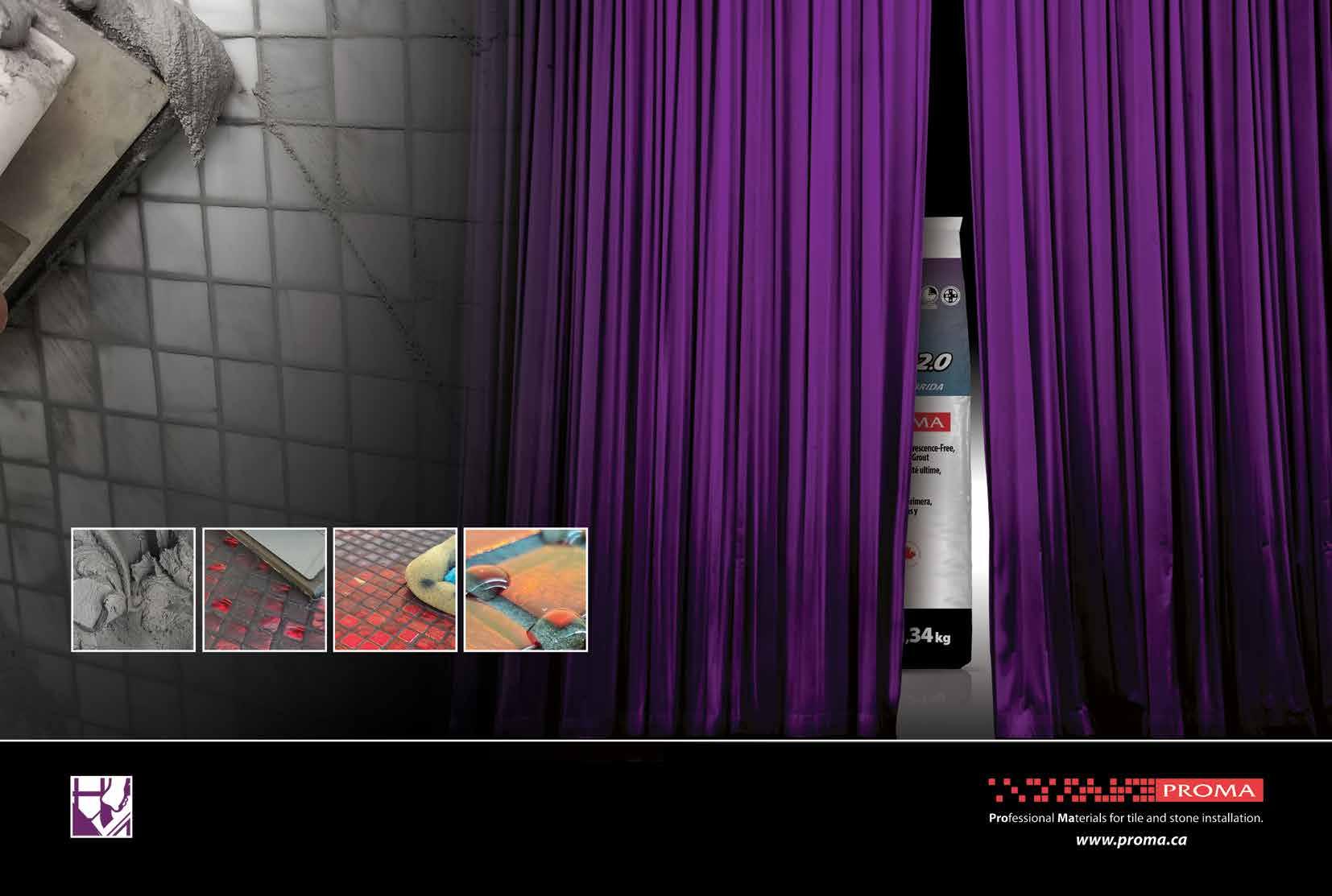

There’s no denying the past couple of years have dramatically altered views about how and where people work — especially the role of the physical office. Re mote work has become commonplace for a vast majority whose jobs allow it. According to a recent Pew Research Center survey, 60 per cent of workers say they’d like to contin ue working from home all or most of the time, if possible. This is up from 54 per cent who said the same in 2020.
However, the survey revealed there are still many employees who prefer to go to the of fice, at least part of the time. Six in 10 of these workers say a major reason they rarely or nev er work from home is simply that they prefer
working at the office. A similar share (61 per cent) cite feeling more productive there.
As the post-Covid workplace continues to take shape, the role of the office must shift along with these changing attitudes. Archi tects, designers and facility managers face a significant challenge in adapting the tradi tional office environment to a space people want to return to for inspiration, collabora tion and community. The skillful use of co lour, acoustical control and modular spaces all contribute to how office space can ac commodate a multi-generational workforce with various workstyles and abilities.
Material selection, too, can make a big dif ference in whether a space inspires calm
concentration or energetic collaboration. When it comes to flooring materials, carpet is an ideal choice for office environments be cause its acoustical control, design flexibility and underfoot comfort contribute to warm, inviting spaces and it can be adapted to suit a wide range of needs.

Poor acoustics are the greatest criticism people have about their work environment. Analyzed data shows acoustical satisfac tion is the lowest rating in LEED (Leader ship in Energy and Environmental Design) post-occupancy evaluations. The require ment for ‘intellectual work,’ like creative
thinking, problem-solving and collaboration — precisely the kind of work that helps com panies outperform their competition — is 55 decibels. But typical office noise reaches 65 decibels. (For frame of reference, a busy highway averages 85 decibels.) That level of noise leads to a huge loss in productivity, so it is easy to see why people are getting frus trated with noisy offices.
Every time a person is distracted by un wanted noise, it takes an average of 15 min utes to regain concentration. If each em ployee has five noise-related distractions in an eight‐hour day, that equates to a 15 per cent reduction in productivity. In a company of 200 staff, this is equivalent to 30 people being paid to do nothing. Installing carpet, along with acoustical ceilings and other ab sorptive surfaces, can help keep noise down and allow people to focus on their work.
Another benefit carpet brings to the work place is the flexibility to create unique spac es that accommodate diverse work styles and preferences. While one employee may prefer a vibrant, open plan area where con versation and collaboration happen nat urally, another may desire a softer, cozy space similar to the home office they’ve become accustomed to over the past few years. Carpet can accommodate both ends of this spectrum and even be designed in ways that strengthen organizational cul ture, by adding logos or other graphical el ements.
Those who work in environments with natural elements, such as greenery and sun light, report a 15 per cent higher level of cre ativity than those with no connection to nat ural elements. Even when these elements are not available, new carpet technologies can simulate their appearance and effects to increase joy and overall wellness.
Neurodiversity, which refers to variations in human neurocognitive functioning like the different ways people think, process informa tion and relate to others, is an important con sideration for workplace design. One in seven people are estimated to have a neurodiverse condition, such as attention-deficit/hyperac tivity disorder, autism, dyspraxia, dyslexia or Tourette’s syndrome. Less than half are aware of their condition and very few businesses are designing workplaces to accommodate their needs. Yet people with these conditions often have a unique perspective on the world that can help unlock innovation, creativity and big picture thinking in organizations.
How an office environment is designed — and the types of materials installed throughout the space — can impact thinking, behaviour, engagement, social awareness and interactive experiences.
Carpet’s flexibility is just one way design ers can create spaces that accommodate people of all abilities and workstyles.
While carpet has many benefits for the work place, its contribution to healthy indoor air quality (IAQ) isn’t usually the first one that comes to mind. But if the right product is cho sen, soft surface flooring can help contribute to better IAQ in the office in significant ways.
Among the biggest worries facility man agers have with carpet is moisture, since damp carpet can lead to mould or microbial growth. However, there are options that of fer the benefits of carpet combined with the long-lasting performance and sustainability attributes of resilient flooring.
One such product is a heterogeneous con struction of nylon and closed-cell imperme able cushion. Fused together through heat and pressure, the layers are integral and in separable. The innovative closed-cell cush ion provides a wall-to-wall moisture barrier for the life of the product, allowing any mois ture to stay on top of the floor instead of seeping down to the subfloor where mould and mildew can grow.
Leslie Thompson is director of workplace strategy for Tarkett North America. As part of strategic marketing, Leslie works closely with design on trend forecasting, research and new product development for the workplace segment. She finds inspiration in collaborative dialogue with the architecture and design community, International Interior Design Associ ation, CoreNet and the global Tarkett group to further expand the company’s design leader ship position.
Most people working just two blocks from Niagara Falls wouldn’t find gushing water very impressive. That is, unless it’s pouring out from a water line inside their facility and onto brand-new flooring.
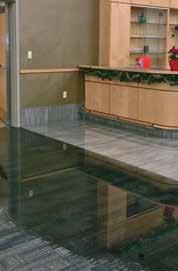
Workers at New York’s Niagara Falls Convention Center had just finished installing 26,000 square feet of flooring and were preparing for a wedding when a clamp on the water line broke. A huge geyser shot up into the air and thousands of feet of just installed floors were flooded in four major areas of the facility.
Using wet vacuums and floor scrubbers, staff worked for several hours to remove all the water. Once it was gone, a local restoration services company began drying the carpet and testing it for damage. But there was none. No smell. No rippling, bubbling or pulling up at the seams. No discolouration. When it was completely dry, the flooring looked brand-new.
That’s because the flooring was Tarkett’s Powerbond, a hybrid resilient sheet flooring featuring a distinctive closed-cell cushion construction that makes it impermeable to wetness; moisture stays on top of the floor, rather than seeping down to the subfloor where mould and mildew can grow.
Just a few days after the facility’s massive leak, the scheduled wedding went off as planned — on the same floors that had been underwater earlier. No sign remained of the extensive flooding throughout the centre.
Carpet is one of the most popular floor ing materials in commercial settings because of its comfort, ability to stand up to foot traffic, and effectiveness in absorbing and improving sound, especially in an open plan layout. The ever-increasing range of available carpet colours, patterns and tex tures also allows for great flexibility in design. Carpet isn’t just used as a neutral backdrop to room furnishings; it’s often chosen to add in terest and dimension to a space and, in some instances, even serves as the focal point.
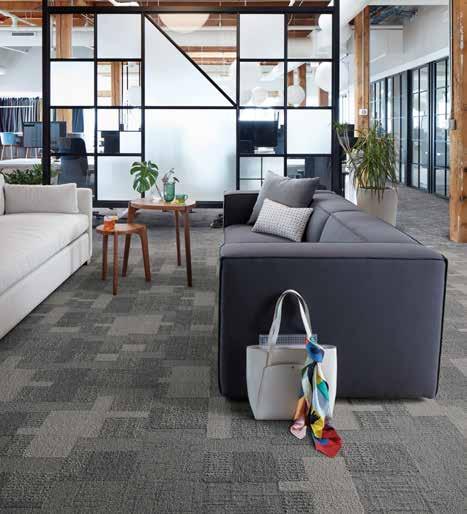
The possibilities for this textile floor cover ing are endless. Coverings wanted to get into
the head of someone who has been design ing this textile for years and looked no further than Interface’s Kari Pei. As vice-president of global product design, Pei has been bringing the brand’s visions to life since 2015. Here, she walks us through the production process, from initial inspiration to actual carpet on the floor.
What are the steps involved in carpet creation?
Kari Pei: There are many beginnings to the creation of a collection or even just one car pet. Sometimes it is from a brief. Others, it is from a desire to challenge the machine.
Occasionally, it is simply a unique idea that comes to mind.
Once the concept is formed, no matter how it started, we draw it out either in Photoshop or a specific application for carpet manufac turing. We take that design through a series of programs to determine thread-up, shifts and pile heights, apply various yarn colours and simulate the installation to inform final designs and format.
We then move to ordering samples and trials from our ‘zero run plant,’ which acts as a labo ratory for designers to assign final pile heights, stitch rates and shifts.
We continue to run trials to refine contrast levels and review the entire colour line. This is both an exercise to make certain the products can be reproduced efficiently and consistent ly, as well as to develop the final trials that are then evaluated and tested by a large group of stakeholders: product design, product de velopment, manufacturing, custom design, field services and marketing. Assuming that aesthetic, performance, install and sustain ablity standards are met, the product/col lection is ready to be introduced to the world of commerce.
Kari Pei: This varies by the size and scope of the collection or product. The process for a single product can happen fairly quickly — six months — compared to a more extensive collection, which takes approximately one and a half years.
Kari Pei: The places I am usually inspired by are art galleries, nature, fashion and also engineer ing unique constructions at the machines.
Kari Pei: Typically, I focus on three key ques tions, asked in two different ways: Is it beauti ful or does it make a person have an emotional reaction? Is it commercially viable or is there a place in the market for it? Is it innovative or does it have a reason for being?
Kari Pei: For commercial spaces, it’s important to offer beautiful products at a competitive price. Ensuring that we meet this need is crit ical and always challenging.
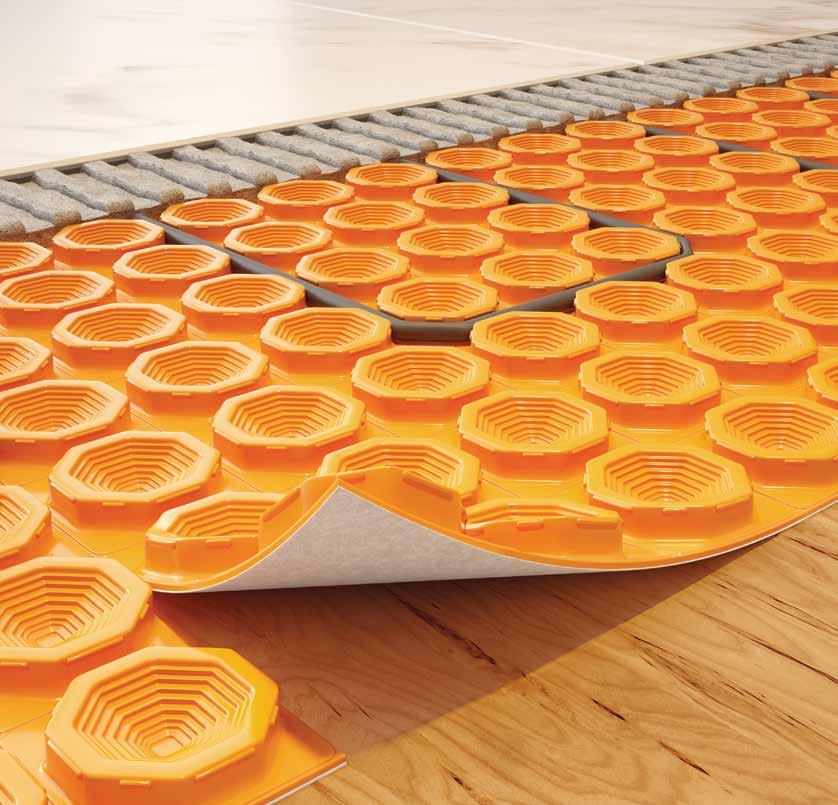





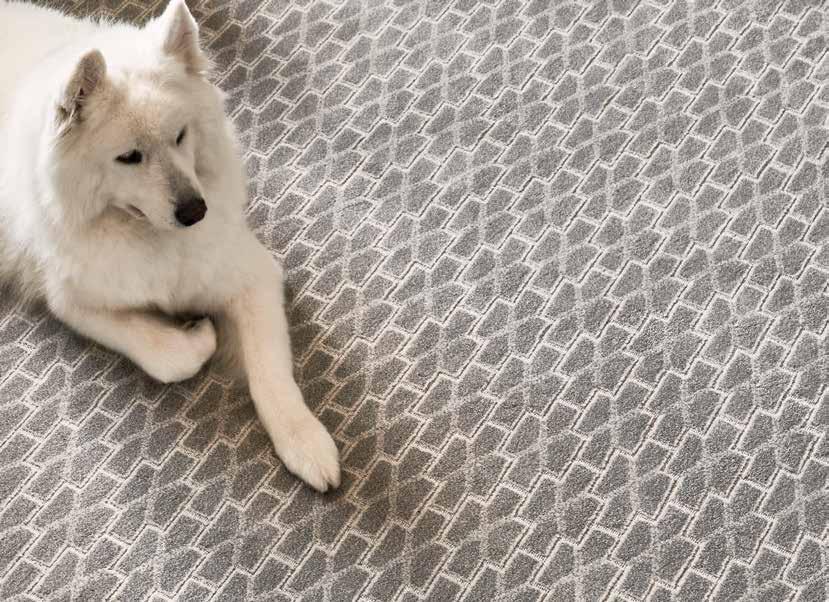
Designed for pet owners. Perfect for pets.
More than 70% of your customers have pets.
Give pet owners the certainty of cleanliness and long-lasting beauty. Pet Perfect+ offers the trusted durability of Pet Perfect, with the added protection of LifeGuard® Spill-proof Technology.


Festool’s integrated suite of dust extractors offer tradespeople cordless, powerful, portable convenience to get their job done. The CTC Sys Cordless Systainer Extractor is lightweight and includes a built-in shoulder strap, making it ideal for small tasks. The 36-volt turbine provides massive suction power that is adjustable in three levels. The appropriate power level can be selected for any given application to maximize battery runtime. The Bluetooth auto-start feature enables the extractor to switch on automatically. It includes a remote control directly on the suction hose. The CTC Midi Cordless Compact Dust Extractor is Festool’s largest and most powerful dust extractor to date. It also features a 36-volt turbine and three levels of extraction power. The large internal hose garage makes the suction hose storage-safe for clean transportation. The flat storage area on top of the hose garage can be used as a shelf for tools or materials, and the integrated T-Loc interface allows the extractor to combine with the systainer-based system. The CTC Midi is equipped with an exterior-accessible filter drawer, enabling quick, tool-free filter replacement. The included HEPA filter means ultimate filtration for clean air.
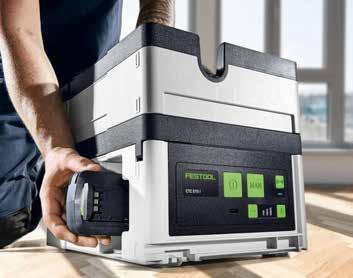
Laticrete’s Vapor Ban E is a single coat, 100 per cent solids, liquidapplied two-part epoxy coating specifically designed for controlling the moisture vapour emission rate from new or existing concrete slabs. It protects moisture and pH-sensitive floor coverings, such as most resinous coatings, vinyl, rubber, hardwood, carpet, ceramic tile and stone, up to 100 per cent relative humidity and reduces the moisture vapour emission rate from less than or equal to 25 pounds to below three pounds. Additionally, Vapor Ban E exceeds the ASTM F3010 (below 0.1 perms) standard and is compatible with non-water-based adhesives. The product can be pigmented with Laticrete’s line of concentrated colourants, Spartacote Universal Pigments. It also accepts a broadcast of Spartacote Blended Chip (flake) or Quartz, which saves an installation step by broadcasting directly into a concrete vapour barrier, and can be used with both the Laticrete Nxt and Supercap product lines of high-performing self-levelling underlayments and traffic-bearing overlays. Vapor Ban E replaces the company’s Nxt Vapor Reduction Coating, Spartacote Moisture Vapor Barrier and Supercap Moisture Vapor Control. The product offers the benefits and features of each of these epoxy moisture mitigation products in an easy-to-use, all-in-one formula. This also simplifies ordering and reduces inventory carrying costs, says the company.
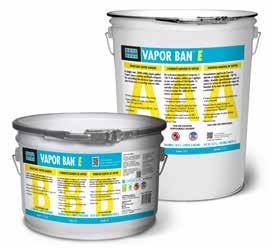
Blade by Ecore is specifically designed for indoor and outdoor ice rink perimeters, walkways, lobbies and locker rooms. The product features a dense and durable design for superior blade resistance to withstand skate traffic. Blade also provides exceptional slip resistance for those walking without skates. The flooring surface is comprised of 9-millimetre dense, vulcanized composition rubber that absorbs shock and easily resists abrasion and degradation caused by equipment like ice skate blades. Its nonporous surface handles many types of wet and dry conditions, including water, humidity, dirt and spills, while providing easy maintenance. Additionally, its surface finish effect is tested to meet ASTM D2047 floor standards. Blade is available in 48-inch wide rolls with a maximum length of 85 linear feet and five different colours.

Daltile’s Rekindle collection of concrete-look porcelain tile is two times more slip-resistant than regular tile, while also eliminating 99 per cent of bacteria on the tile surface, says the company. These superior performance features are made possible through the inclusion of StepWise and Microban technologies that won’t wear off or wash away. The collection is comprised of large format tiles available in 24-inch by 48-inch, 24-inch by 24-inch and 12-inch by 24-inch formats and five earthy tones, including beige, white, various greys and terracotta.
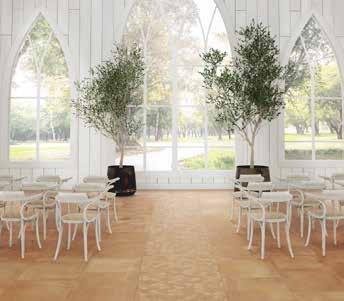
Discovery by Tarkett is a collection of two soft surface flooring options, Visual Path and Mentor, and a coordinating luxury vinyl tile (LVT), all of which were designed around the unique needs of students and educators. With high-definition shapes and lively patterns, Visual Path is created to conjure organization and connectivity with its use of colour and geometry. Conversely, Mentor’s softened painterly lines and diffused pattern is meant to infuse a soothing effect. Both are available in three modular tile sizes and a palette of 12 colours. Method LVT boasts striking geometrics that bring playful energy to any educational space, says the company. The design is available in eight standard colours and can easily be recoloured to match other flooring with Tarkett’s digital printing technology.
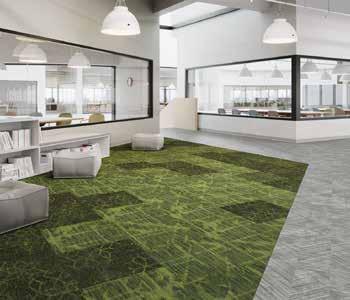
Soft Step by Coretec is a new attached cork underlayment distinguished by its quiet, warm and sustainable benefits. Research performed by the brand shows the underlayment rating as 70 per cent better in sound reduction when compared to other luxury vinyl plank options and 450 per cent superior in warmth when contrasted with stone plastic composite products. Additionally, the underlayment is made from 100 per cent recycled plastic bottles. Soft Step is available in 9-inch by 72-foot by 10-millimetre specs and is featured in 10 styles falling under Coretec’s Original collection. This means the underlayment will be attached to a wood plastic composite core, adding to its quiet and warm benefits.


WarmlyYours’ Snow Melt Embeddable Attachment Grid functions as a framework to attach snow melting cables to when used for heated snow melting systems for projects like outdoor stairs, driveways and walkways. The grid has a 1-inch by 1-inch square pattern so that snow melting cables can be secured to it with cable ties, which helps to maintain not only proper spacing but also the right depth of the heating elements to ensure optimal performance. The product is made of multi-filament polyester yarns, allowing it to be easily cut to shape on the job site, and can be embedded on top of existing concrete surfaces or under pavers, bluestone or tile. It’s available in 3-feet by 50-feet rolls.
Unilin Technologies’ Unizip locking system solves many of the logistical and installation issues associated with a traditional herringbone floor. The technology allows flooring manufacturers to produce one type of panel instead of two, allowing them, as well as distributors and retailers, to reduce the number of SKUs they need to stock. Installation is also made easier since installers can simply work with one pile of panels. The locking system can be used for a wide range of base boards, such as laminate and stone plastic composite.
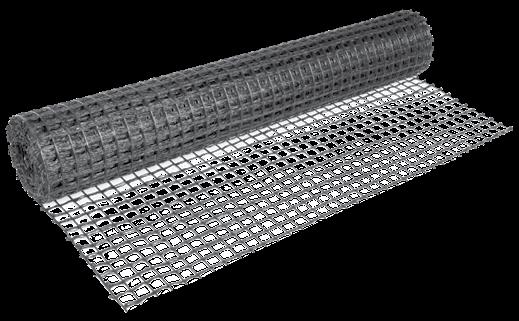
Seven in 10 small business owners expect interest rate hikes to have a negative impact on their operations. Almost two-thirds of Canadian small businesses are still saddled with pandemic debt, for an average of $158,000. Nearly 80 per cent have raised their prices more than usual in the past year to compensate for rising costs.
—Canadian Federation of Independent BusinessOntario is feeling the impact of high inflation and rising interest rates. There is, however, reason for optimism as investments from governments and businesses continue to be made in the province, which will help boost the economy during an anticipated recession. Ontario’s economy is slated to grow 3.9 per cent in 2022, 1.7 per cent in 2023, and 2.2 per cent in 2024.
—Conference Board of CanadaForty per cent of Canadian companies plan to add new permanent staff during the second half of 2022, despite talk of a potential economic slowdown. In addition to hiring for full-time functions, 45 per cent of employers will bring in more contract talent by year-end to stay agile in an everchanging hiring landscape. Eighty-nine per cent of managers say it is challenging to find skilled professionals, primarily due to a lack of qualified talent and candidates’ salary expectations being higher than what their company is willing to offer.
—Robert Half
3%Canadian housing starts fell to 267,443 units in August, a 3 per cent drop from July. The decline was driven my lower multi-unit urban starts, which dipped 4 per cent to 187,602 units. Singledetached urban starts increased 1 per cent to 59,169 units. Toronto posted strong increases across the board, while Montreal recorded a large (33 per cent) decline in multi-unit starts, resulting in the overall decline for Canada.
Retail sales decreased 2.5 per cent to $61.3 billion in July, the first decline observed in seven months. Sales were down in nine of 11 subsectors, representing 94.5 per cent of retail trade. Ontario led the decline (5 per cent) among all provinces, with Toronto seeing sales drop by 5.7 per cent.
—Statistics Canada
The kitchen and bath industries are seeing signs of a cool down, with decelerated growth expected through the rest of the year. Sales are now expected to increase by 9.4 per cent, down from the 15.1 per cent originally projected. Kitchen and bath sales grew 6.9 per cent in the second quarter of 2022, over the same time period last year. This marked the second consecutive quarterly deceleration in year-over-year sales growth.
—National
Beautiful & healthy for those you love most.™
Trust TruTEX™ to go where other floors cannot. From kids’ bathrooms to damp basements, the TruTEX™ moisture management system enhances the life, beauty and performance of your floors. Plus, it resists stains, mold and mildew while delivering Beyond Tough performance.
Inspired by nature.
Engineered for the home.
Borrowing inspiration from a tree’s natural lines and furrows, Talk of the Town offers a multi-texture wood grain pattern in 11 soft earth tones for graceful style and quiet elegance in virtually any room. Made of 100% solution dyed Primus ® PET Fiber.
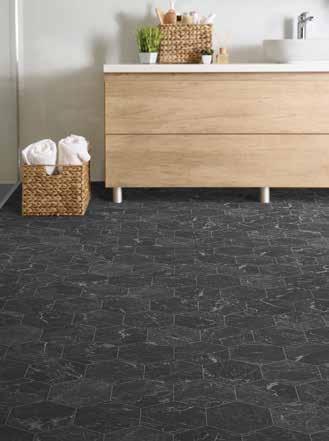

New look of Niagara Falls visitor centre complements Canada’s greatest natural wonder
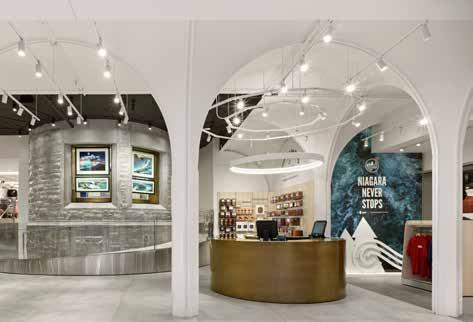 By Johnson Chou
By Johnson Chou
Situated at the precipice of Niagara Falls, the Table Rock Wel come Centre is a ‘hub’ that functions in a supporting role to visitors’ appreciation of the awe-inspiring, cascading Niagara River as it plunges over a cliff of dolostone and shale. Comprised of a central circulation hall, retail spaces, an upscale restaurant and fast casual dining, the project is inspired by the rich cultural history of the site and the beauty of the surrounding natural environment. Consis tent with Niagara Parks’ core values of sustainability, education, in spiration and innovation, the challenge was to seek a balance against the prosaic needs of a famed tourist destination, and elevate and rep resent those core values through an overt sense of reverence, defer ence and authenticity.
‘River,’ the main circulation hall, flows through the centre, connecting the attractions, retail and hospitality components of the building, including the main entry, Table Rock House Shop, Table Rock Market and Journey Behind the Falls. The ceiling, illuminated in a soothing light blue, is com posed to be evocative of flowing, rushing water, echoing the stream of pedestrian movement. As in the restaurant overlooking the falls, co loured lighting mirrors the nightly coloured illumination of the world won der, which has become iconic in itself.
The interior finishes were selected to reference outdoor surround ings, bringing them inside. It was desired that flooring have visual move ment and texture, like cleft or textured natural stone. Large format Sil ver/K-Slate porcelain tiles from Centura were used extensively, paired

with the darker Spazzolata Mat/STI Piase from Stone Tile. K-Slate has more texture, resembling cleft slate, while STI Piase is rich in its depth of colour, punctuated by movement evoked by graphic ‘veining.’
Table Rock House Restaurant was envisioned to amplify the dra matic, immediate and expansive view of Niagara Falls. The en trance sequence was reconfigured to visually connect the guest with a prolonged view of the falls as they land on the dining level via an extended ramp. The radial configuration of the dining and bar ar eas result in every seat having a dramatic view.

Flooring finishes were selected for their aquatic imagery and natural appearance. The carpeting specified was Interface Caspian and Pa cific/Net Effects One for its beautiful patterns and colouring that are evocative of textured waves supported with impressive durabil ity. Porcelain surfaces included the specification of Moka/K-Slate on the entrance ramp and bar areas, again with the aggressive tex ture underscoring the references to the environment.
Johnson Chou is the founder and principal at Toronto-based Johnson Chou Inc., an interdisciplinary design practice encompassing architectural and industrial design, furniture, interiors, graphic identity and corporate communications — a body of work characterized by conceptual explorations of narrative, transformation and multiplicity. He can be reached at johnson@johnsonchou.com.
